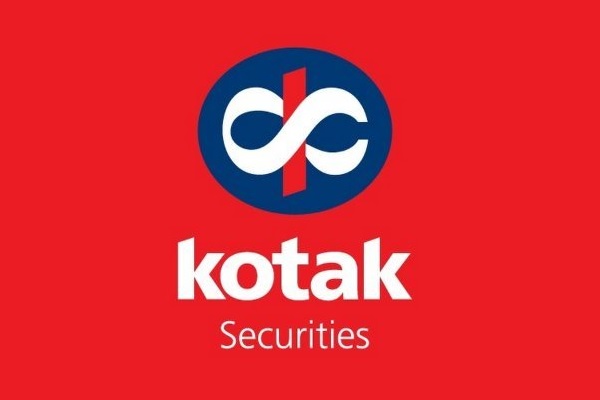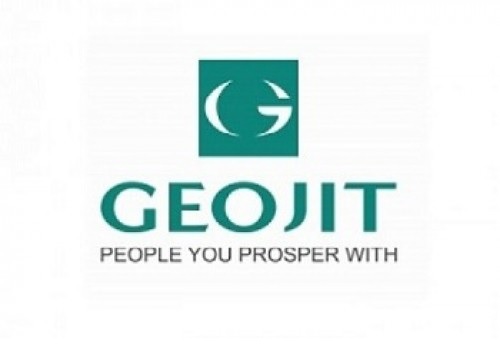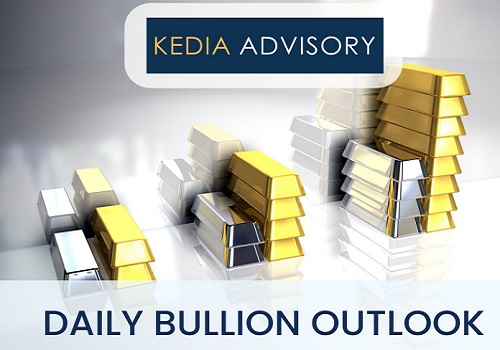Cottoncandy trading range for the day is 53230-54570 - Kedia Advisory

Gold
Gold prices declined sharply by 3.75% to settle at Rs.92,901, pressured by easing geopolitical tensions and a significant reduction in US-China trade tariffs, which dented safe-haven appeal. Following productive trade negotiations in Switzerland, the US announced a tariff cut on Chinese goods from 145% to 30%, while China reciprocated by slashing levies on US imports from 125% to 10%—both for a 90-day period. This marked a notable de-escalation in the trade conflict, lifting global risk sentiment and reducing demand for non-yielding assets like gold. Further weighing on prices was the Federal Reserve’s cautious stance. Fed Chair Powell emphasized inflation concerns and labor market risks, ruling out any preemptive rate cuts, which helped strengthen the US dollar and added pressure on gold. On the physical front, Indian gold dealers were forced to offer discounts—up to $16 per ounce—due to high local prices fueled by a weaker rupee. According to the World Gold Council, global gold demand rose 1% year-on-year in Q1 2025 to 1,206 metric tons, primarily driven by a 170% surge in investment demand, despite a 21% drop in jewelry consumption and a 21% decline in central bank buying. Technically, the gold market is under long liquidation, as open interest fell by 10.73% to 12,815. Immediate support lies at Rs.91,690, and a break below this could drag prices to Rs.90,485. On the upside, resistance is seen at Rs.94,800, with further gains likely up to Rs.96,705 if momentum resumes.
Trading Ideas:
* Gold trading range for the day is 90485-96705.
* Gold fell followed by news of a major tariff rollback by the US and China.
* US announced it would cut tariffs on Chinese goods from 145% to 30, for a 90-day period.
* China will lower levies on US imports from 125% to 10%, for a 90-day period.
Silver
Silver prices declined by 1.43% to settle at Rs.95,344 as easing geopolitical tensions and a breakthrough in U.S.-China trade relations dampened the demand for safe-haven assets. The landmark agreement saw the U.S. slash tariffs on Chinese goods from 145% to 30%, while China reciprocated by reducing duties on U.S. imports from 125% to 10%. This move lifted global risk appetite and triggered profit-booking in precious metals, including silver. Additionally, a fragile but holding ceasefire between India and Pakistan contributed to the improved risk sentiment, further reducing safe-haven inflows. Despite the short-term bearish sentiment, silver's long-term fundamentals remain robust. The trade truce is expected to stimulate industrial activity, particularly in sectors like renewable energy, where silver plays a key role. According to the Silver Institute, the silver market is projected to post a deficit for the fifth consecutive year in 2025, driven by sustained industrial demand. Industrial fabrication is set to hit a record high, with volumes forecast to surpass 700 million ounces, bolstered by growth in green economy applications. While jewelry and silverware demand is expected to decline, especially in India due to elevated local prices, physical investment demand is poised to rebound by 3% in Western markets. On the technical front, the market is under fresh selling pressure as open interest rose 6.02% to 17,065. Immediate support is seen at Rs.93,920, with further downside potential towards Rs.92,500. Resistance lies at Rs.96,705, and a break above that could take prices to Rs.98,070.
Trading Ideas:
* Silver trading range for the day is 92500-98070.
* Silver prices dropped following a major breakthrough in U.S.-China trade relations.
* U.S. tariffs on Chinese goods will be cut from 145% to 30%, while China will lower its duties on U.S. imports from 125% to 10%.
* The improved risk sentiment, further bolstered by a fragile but holding ceasefire between India and Pakistan, weighed broadly.
Crude oil
Crude oil prices edged higher by 1.53% to settle at Rs.5,292, supported by a breakthrough in U.S.-China trade relations that eased demand concerns. Both nations agreed to reduce tariffs significantly—U.S. tariffs on Chinese goods were slashed from 145% to 30%, and China reciprocated by cutting duties on U.S. imports from 125% to 10%, for a 90-day period. This development is seen as a positive step for global trade and is particularly beneficial for crude demand, given that the U.S. and China are the two largest oil consumers globally. However, the bullish sentiment was partially offset by several bearish signals. OPEC+ is planning to accelerate output hikes in May and June, which could add to global supply. Additionally, the potential revival of the U.S.-Iran nuclear deal raises the prospect of more Iranian oil entering the market. The International Energy Agency (IEA) also added to the downside by forecasting a global oil supply surplus of about 600,000 barrels per day in 2025, which could expand further if OPEC+ fails to manage output effectively. U.S. crude inventories fell by 2.032 million barrels last week, exceeding expectations, while Cushing stocks dropped by 740,000 barrels—lending support to prices. Technically, the market is under short covering, with open interest down by 16.08% to 12,059 contracts. Crude oil finds support at Rs.5,191, with a further downside target of Rs.5,091. On the upside, resistance is seen at Rs.5,395, and a break above that could lead to a test of Rs.5,499.
Trading Ideas:
* Crudeoil trading range for the day is 5091-5499.
* Crude oil climbed after the US and China agreed to reduce most tariffs on each other’s goods.
* OPEC+ plans to accelerate output hikes in May and June.
* A potential US-Iran nuclear deal, could ease concerns about global oil supply shortages.
Natural gas
Natural gas prices declined by 3.85% to settle at Rs.310, pressured by rising production levels and weaker demand from LNG export facilities. Despite forecasts indicating higher gas demand this week, bearish sentiment prevailed due to increased output and lower export-related activity. The average gas production in the Lower 48 U.S. states fell to 103.7 billion cubic feet per day (bcfd) in May so far, slightly below April’s record of 105.8 bcfd. A contributing factor to the supply pressure is associated gas production, which accounts for about 37% of total U.S. gas output. Any slowdown in oil production could reduce this associated gas supply in the future, but currently, elevated output remains a concern. Additionally, U.S. utilities added 104 Bcf of gas to storage last week, keeping stocks at 2,145 Bcf—16.1% below last year’s levels but 1.4% above the five-year average, maintaining a balanced storage outlook. Interestingly, speculators turned net buyers for the first time in nine weeks, signaling a potential shift in sentiment. Furthermore, the EIA projects record highs in both gas output and consumption for 2025 and 2026, driven by rising domestic demand, although consumption is expected to slightly taper off by 2026. Technically, the market is under long liquidation, with open interest falling sharply by 27.69% to 13,026. Immediate support lies at Rs.302.4, with further downside seen at Rs.294.9. Resistance is pegged at Rs.321.7, and a breakout above that could push prices toward Rs.333.5.
Trading Ideas:
* Naturalgas trading range for the day is 294.9-333.5.
* Natural gas fell on a rise in output in recent days coupled with a decline in gas flows to LNG export plants.
* That price drop came despite forecasts for more demand this week than previously expected.
* Speculators last week boosted their net long futures and options positions for the first time in nine weeks.
Copper
Copper prices edged marginally lower by 0.04% to close at Rs.851.3, amid profit booking following recent gains driven by easing U.S.-China trade tensions. Market sentiment improved significantly after the two global economic powerhouses agreed to lower tariffs, alleviating fears of prolonged trade disruptions and bolstering risk appetite. However, bullish momentum was tempered by renewed concerns about oversupply, especially due to strong ore production from South America. The International Copper Study Group (ICSG) recently doubled its global copper surplus forecast for 2025 to nearly 300,000 tonnes, signaling ample supply. Chinese traders, previously bullish on U.S. copper futures due to tariff concerns, have begun unwinding long positions, further pressuring prices. Additionally, a sharp increase in COMEX copper inventories—up 61% since March-end to 156,623 tonnes—reflects the redirection of global copper shipments toward the U.S., preemptively avoiding potential import tariffs. On the supply-demand front, the global refined copper market registered a surplus of 61,000 metric tons in February, down from 90,000 metric tons in January. Chinese bonded warehouse inventories also showed a surplus, indicating persistent oversupply. Despite this, signs of demand resilience are emerging. Technically, copper is under long liquidation, as open interest declined by 7.85% to 6,127 contracts. Support is placed at Rs.848.6, with further downside seen at Rs.845.7. Resistance lies at Rs.854.9, and a breakout above could push prices toward Rs.858.3.
Trading Ideas:
* Copper trading range for the day is 845.7-858.3.
* Copper pared gains on profit booking after prices gained amid easing US-China trade tensions.
* At the same time, robust ore production from South America added to concerns of oversupply
* ICSG recently doubled its forecast for this year’s surplus to nearly 300,000 tonnes.
Zinc
Zinc prices closed slightly higher by 0.46% at Rs.252.15, supported by improved market sentiment following a temporary easing in U.S.-China trade tensions. The announcement of a 90-day tariff reduction period—where the U.S. will cut tariffs on Chinese goods from 145% to 30% and China will lower duties on U.S. imports from 125% to 10%—helped alleviate geopolitical uncertainties and provided some relief to the industrial metals complex. However, the upside in zinc remains capped amid concerns about rising supply. The International Lead and Zinc Study Group (ILZSG) has forecast a surplus in the refined zinc market for 2025. Global refined zinc demand is expected to grow modestly by 1% to 13.64 million tons, while output is projected to increase by 1.8% to 13.73 million tons, driven by better concentrate availability. Mined zinc production is also forecast to rise significantly by 4.3% to 12.43 million tons this year, following years of contraction due to mine closures. China's refined zinc production in March 2025 saw a robust 14% monthly increase and a 4% year-on-year gain, exceeding expectations. The production rise was fueled by improved zinc concentrate treatment charges (TCs), higher sulphuric acid prices, and the post-holiday resumption of operations across major producing provinces. Technically, the market is under short covering, evidenced by a 7.04% drop in open interest to 2,035 contracts. Zinc finds immediate support at Rs.250.3, with a break below likely to test Rs.248.2. Resistance is seen at Rs.254.7, and a move above that could drive prices toward Rs.257.
Trading Ideas:
* Zinc trading range for the day is 248.2-257.
* Zinc gains following the announcement of a temporary deal between US and China to reduce tariffs.
* The U.S. will cut extra tariffs it imposed on Chinese imports in April this year to 30% from 145%.
* Global refined zinc demand is forecast to rise by 1% to 13.64 million tons this year
Aluminium
Aluminium prices climbed 1.63% to close at Rs.237.35, buoyed by positive sentiment following a significant breakthrough in U.S.-China trade relations. Over the weekend, both countries agreed to reduce tariffs substantially—U.S. tariffs on Chinese goods will be lowered from 145% to 30%, while China will cut duties on U.S. imports from 125% to 10%. This development has lifted market optimism and offered temporary relief to industrial metals, including aluminium, by reducing geopolitical and trade-related uncertainty. However, the rally faces headwinds due to oversupply concerns and muted macroeconomic fundamentals. China's aluminium production in March rose 4.4% year-on-year to 3.75 million metric tons, with total output for the first quarter reaching 11.07 million tons—up 3.2% from the same period last year. As domestic production nears its cap of 45 million tons, Chinese producers are expanding capacity overseas, further adding to global supply pressure. On the international front, global primary aluminium output rose by 2.3% year-on-year to 6.227 million tonnes in March, according to the International Aluminium Institute. Meanwhile, aluminium exports from China surged 17% year-on-year in the first ten months of the year, reflecting strong outbound flows amid a favorable global demand environment. Technically, the market is under short covering, as open interest dropped by 6.92% to 4,265 while prices moved higher. Support for aluminium is now seen at Rs.233.6, and a break below this could lead to testing Rs.229.9. Resistance is anticipated at Rs.240.5, and a move above this level may push prices toward Rs.243.7.
Trading Ideas:
* Aluminium trading range for the day is 229.9-243.7.
* Aluminium gains after the U.S. and China agreed to significantly reduce tariffs
* China will lower its levies on U.S. imports from 125% to 10%—a move widely seen as a major step toward easing bilateral trade tensions.
* Global primary aluminium output in March rose 2.3% year on year to 6.227 million tonnes
Cottoncandy
Cottoncandy prices settled marginally lower by 0.04% at Rs.53,980, reflecting mild profit booking after recent gains. The price movement followed a revised domestic crop estimate by the Cotton Association of India (CAI), which further trimmed production forecasts for the 2024–25 season by 4 lakh bales to 291.30 lakh bales of 170 kg each, primarily due to reduced output in Maharashtra. The downward revision in output reflects tighter domestic supply conditions, supporting a generally firm undertone in cotton prices despite the current correction. CAI estimates the total cotton supply till the end of March at 306.83 lakh bales, which includes 25 lakh bales of imports and opening stocks of 30.19 lakh bales. Stocks as of March-end stood at 127.83 lakh bales, with 27 lakh held by mills and the remainder distributed between CCI, the Maharashtra Federation, and private trade. Notably, India’s cotton imports are projected to more than double in 2024–25 to 33 lakh bales from last season’s 15.20 lakh bales, reflecting the need to compensate for lower domestic production. Exports, however, are forecast to decline to 16 lakh bales, down significantly from 28.36 lakh bales last year, indicating a cautious trade outlook. Globally, the U.S. and world cotton balance sheets show lower exports and consumption, while stocks have been revised upwards. Mill use is down in China and Indonesia, whereas Turkey saw increases. Technically, the market is under long liquidation, with open interest remaining unchanged at 241. Support lies at Rs.53,600, with further downside possible toward Rs.53,230. Resistance is seen at Rs.54,270, and a break above could test Rs.54,570.
Trading Ideas:
* Cottoncandy trading range for the day is 53230-54570.
* Cotton dropped on profit booking after prices gained as CAI expects a shrinkage in the domestic crop further.
* Cotton exports for the 2024-25 season are pegged at 16 lakh bales, lower by 12.36 lakh bales over previous year’s 28.36 lakh bales.
* The closing stock for 2024-25 season at end of September 2025 is estimated lower at 23.49 lakh bales from same period last year’s 30.19 lakh bales. I
* In Rajkot, a major spot market, the price ended at 26123 Rupees gained by 0.22 percent.
Turmeric
Turmeric prices surged by 3.61% to settle at Rs.14,116 amid easing geopolitical tensions between India and Pakistan, which supported market sentiment. However, gains were capped due to increased arrivals and subdued export demand. Total arrivals rose sharply to approximately 57,500 quintals, nearly doubling from the previous session's 29,860 quintals, exerting some supply-side pressure. Despite this, the downside remained limited due to persistent concerns over lower production estimates and delayed arrivals from key producing regions. This season, the turmeric acreage increased by 10% to 3.30 lakh hectares from last year's 3 lakh hectares. However, output may not see a proportionate rise due to adverse weather conditions, including untimely rains that have negatively impacted productivity. Last year's production stood at 10.75 lakh tonnes, but the current season is expected to yield 10–15% lower output. From a trade perspective, turmeric exports between April and February 2025 rose by 11.51% to 161,229.56 tonnes. However, February exports dropped marginally by 2.97% YoY. Imports saw a significant YoY rise of 55.21% during the same period, though February's monthly figures showed sharp declines both month-on-month and year-on-year, indicating reduced overseas supply pressure. Technically, the market witnessed fresh buying with open interest increasing by 4.97% to 15,305. Turmeric has immediate support at Rs.13,882 and a break below could test Rs.13,646. On the upside, resistance is seen at Rs.14,292, and a move above this level could push prices to Rs.14,466.
Trading Ideas:
* Turmeric trading range for the day is 13646-14466.
* Turmeric prices rallied as support seen after easing of tension between India and Pakistan border.
* Total arrivals rose to around 57,500 quintals, up significantly from 29,860 quintals in the previous session.
* However downside seen limited as persistent concerns about low arrivals and lower production estimates.
* In Nizamabad, a major spot market, the price ended at 14535.7 Rupees gained by 1.39 percent.
Jeera
Jeera prices surged by 4.18% to close at Rs.22,195, supported by improved sentiment following the ceasefire agreement between India and Pakistan, which eased geopolitical tensions and boosted investor confidence across regional assets. However, the upside remains limited due to subdued domestic and export demand, along with the end of the retail buying season and inactivity from foreign buyers. Increased arrivals in major mandis, rising from 28,000 to 32,900 bags, have further pressured the market by boosting supply. Despite a delayed start in sowing, due to unfavorable weather in Gujarat and Rajasthan, cumin crop conditions are reportedly better this season, with production expected to match last year’s levels. Farmers still hold about 20 lakh bags of cumin, but only 3–4 lakh bags are anticipated to be traded before the end of the season, resulting in a carry-forward stock of approximately 16 lakh bags. Export data shows strong growth, with jeera exports rising 62.55% year-on-year during April–February 2025 to 195,164.58 tonnes. However, February exports dropped 23.92% month-on-month, although they were still up 18.52% compared to February 2024. On the import front, jeera imports plummeted by 93.70% during the same period, reflecting higher domestic availability and reduced overseas dependence. Technically, the market is under fresh buying pressure as open interest surged by 7.38% to 5,325 contracts. Jeera has immediate support at Rs.21,830 and may test Rs.21,460 on further weakness. Resistance is seen at Rs.22,430, and a breakout above this could push prices towards Rs.22,660.
Trading Ideas:
* Jeera trading range for the day is 21460-22660.
* Jeera gains as the ceasefire between India and Pakistan eased concerns of escalating warfare.
* Total arrivals in major mandis rose to 32,900 bags from 28,000 bags in the previous session, increasing supply side pressure.
* Traders attributed the fall mainly to the conclusion of the retail season and continued inactivity on the part of foreign buyers.
* In Unjha, a major spot market, the price ended at 21966.1 Rupees dropped by -0.52 percent.
Views express by all participants are for information & academic purpose only. Kindly read disclaimer before referring below views



.jpg)

















